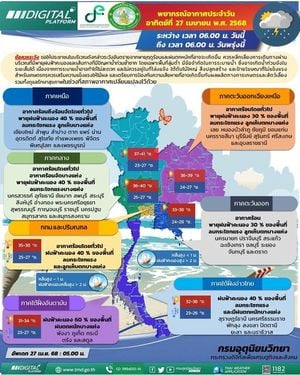The Spring Equinox, also known as Verbonosice, marks a significant turning point in the year, celebrated for its beauty and cultural importance. On March 20, 2025, day and night will be of equal length, a phenomenon that occurs due to the Sun crossing the celestial equator and transitioning from the southern to the northern hemisphere. This year's equinox is special; it is a time for celebrations, when communities come together through songs and dances, reconnecting with nature and welcoming the rebirth of life that occurs in spring.
The excitement for this event can be traced back many centuries and across various cultures. The Slavic peoples, for instance, have a rich history associated with this day. Traditionally, celebrations would commence early in the morning when households prepared special foods like cookies shaped like birds, pancakes, and other delicacies. This was more than merely a culinary effort; it symbolized the end of winter and the awakening of the earth after its long sleep.
Preparatory rituals included cleaning households of old items and welcoming the new. Communities would gather for fairs and festivities filled with songs and dances, enjoying games that linked them to their ancestral heritage. Fire was often part of the evening festivities, where bonfires were lit as a way to symbolically chase away the remnants of winter cold.
In 2025, the Spring Equinox will coincide with a magical occurrence. Notably, the Sun will cross the equator exactly on March 20, marking a celestial event that leads to increased daylight hours, enhancing the seasonal dynamics that farmers depend upon. With the arrival of spring, farmers begin preparations for sowing crops. The increasing daylight serves not only as a symbol of rebirth but also as a practical guide for agricultural activities.
As nature wakes up, various signs of spring begin to emerge. Many animals awaken from hibernation; the birds reappear in their nesting grounds, and the first blossoms punctuate the landscape. The appearance of the silver willow and the sound of migrating birds herald the arrival of warmer weather ahead. A notable sign this year is the song of the larks, which are believed to signify that spring has indeed claimed its ground.
The Spring Equinox has also held significance in various religious contexts. Many cultures view this day as a moment of balance between light and dark, leading to rituals that seek harmony and connection with those who have passed. It is a time when the veil between the worlds of the living and the dead is considered thinner, making it easier to commune with the spirit world.
The celebration of the equinox is beautifully intertwined with agricultural traditions around the world. Festivals to mark the beginning of soil tillage and sowing season are common. In the message of thanks and hope, people have often prayed to the gods for abundance in the months to come.
Interestingly, the date of the Spring Equinox may shift slightly each year but is typically observed between March 19 and March 21. In 2025, it lands firmly on March 20. Over the coming century, predictive patterns suggest the equinox might even arrive earlier in leap years, with instances in 2096 edging towards March 19. Already, predictions for seasons like autumn reflect a similar pattern where equinoxes subtly shift as time progresses. The equinox is not just a marker on the calendar; it is an astral event with roots deep in our connection to the environment.
The traditions surrounding the Spring Equinox continue to flourish in the modern world. For many, it is a joyous occasion to welcome the renewal of life and celebrate human connection with nature. From community festivities in Kazakhstani and Uzbek cultures related to the arrival of Navruz—the Persian New Year—to the Eastern practices observed in China, where tree planting is common during this time, the universal joy of spring is vividly displayed.
In conclusion, the Spring Equinox serves as a powerful reminder of the cycles of nature and the rhythms of life that connect us all. As society continues to evolve, the importance of such astronomical events remains a cherished part of human culture, exemplifying our desire to find balance and harmony amid the changing seasons.





